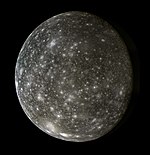
Callisto, or Jupiter IV, is the second-largest moon of Jupiter, after Ganymede. In the Solar System it is the third-largest moon after Ganymede and Saturn's largest moon Titan, and nearly as large as the smallest planet Mercury. Callisto is, with a diameter of 4,821 km, roughly a third larger than Earth's Moon and orbits Jupiter on average at a distance of 1,883,000 km, which is about five times further out than the Moon orbiting Earth. It is the outermost of the four large Galilean moons of Jupiter, which were discovered in 1610 with one of the first telescopes, and is today visible from Earth with common binoculars.
This is a directory of lists of geological features on planets excepting Earth, moons and asteroids ordered by increasing distance from the Sun.

Tindr is a crater on Jupiter's moon Callisto. It is named after one of the ancestors of Ottar in Norse mythology. This is an example of a central pit impact crater.

Hár is a crater on Jupiter's moon Callisto. Its name is one of the many names of Odin, the supreme god in Norse mythology. This is an example of a central dome impact crater.
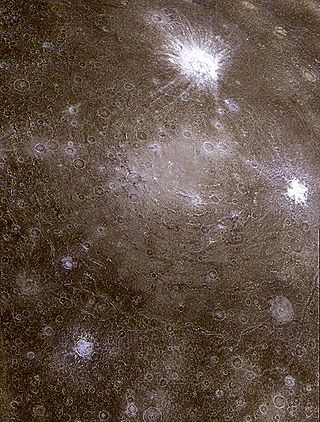
Asgard is the second largest multi-ringed basin on Jupiter's moon Callisto. It is named after Asgard, the realm of the gods in Norse mythology. The central part of Asgard is dominated by the domed Doh impact crater.

Located on Jupiter's moon Callisto, Valhalla is the largest multi-ring impact crater in the Solar System. It is named after Valhalla, the hall where warriors are taken after death in Norse mythology.
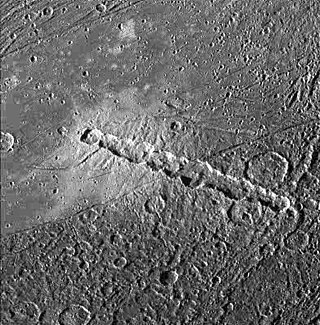
A crater chain is a line of craters along the surface of an astronomical body. The descriptor term for crater chains is catena, plural catenae, as specified by the International Astronomical Union's rules on planetary nomenclature.

Adlinda is the third-largest multiring structure on Jupiter's moon Callisto, measuring roughly 1000 km in diameter. It is situated in the southern hemisphere of Callisto. The name is taken from Inuit mythology.

Keelut is a crater on Jupiter's moon Callisto. It is situated near the south pole and is an example of a central pit impact crater. It measures 47 km across.

Arcas is a crater on Jupiter's moon Callisto measuring 60 km (37 mi) across. It is an example of a central pit impact crater. A smaller crater near Arcas is called Ginandi. The crater is named after Arcas, the son of Callisto in Greek mythology.

Jalkr is a bright crater on Jupiter's moon Callisto measuring 74 km across. This an example of a central dome impact crater. A smaller degraded crater in the upper part of the image is called Audr.

Arecibo Catena is a catena on Mercury. It is named after Arecibo Observatory, the former large radio telescope in Puerto Rico.
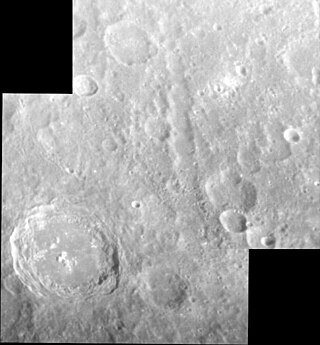
Haystack Catena is a catena on Mercury. It superficially resembles a graben but is a chain of overlapping secondary craters. It is named after Haystack Observatory, and was originally named Haystack Vallis when it was imaged by Mariner 10 in 1974, but the name was changed in 2013 to better reflect its origin. It is approximately 274 km long. It is located near the center of the Kuiper quadrangle, and it is radial to a large, unnamed crater that is Tolstojan in age.

Lofn is a large and relatively young impact crater on Jupiter's Galilean satellite Callisto. It was identified in 1997 and named after the goddess of marriage in Norse mythology. Located near the south pole of this moon, Lofn is classified as a flat floored or anomalous dome impact crater. It is superimposed on Adlinda multilayer structure obscuring about 30 percent of it. Another multi-ring structure—Heimdall is found to the south-west of Lofn.

Tractus Catena is a set of pits in the Arcadia quadrangle of Mars. Its location is centered at 28.17°N 102.77°W. It is 897 km (557 mi) long and was named after a classical albedo feature name. The term "Catena" refers to a chain of craters.
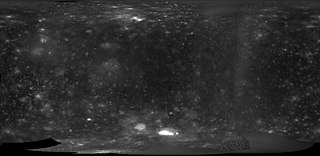
Heimdall is one of the largest known impact craters on Jupiter's Galilean satellite Callisto, with a diameter of 210 km. It is located near the Callistoan south pole at 63.5°S 3°E. It was firstly suspected on Voyager images, and later confirmed by Galileo.















